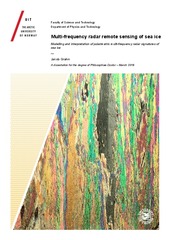Multi-frequency radar remote sensing of sea ice. Modelling and interpretation of polarimetric multi-frequency radar signatures of sea ice
Permanent lenke
https://hdl.handle.net/10037/13373Dato
2018-06-08Type
Doctoral thesisDoktorgradsavhandling
Forfatter
Grahn, JakobSammendrag
This thesis deals with polarimetric multi-frequency radar signatures of sea ice. It presents a thorough background on the topic and three case studies.
The first study presents a global sensitivity analysis of the fully polarimetric radar backscatter response from snow covered sea ice. The analysis is global in the sense that it takes into account the observed ranges of sea ice properties that are needed as input, and it attributes a quantitative sensitivity measure to each individual input parameter, such that the most influential one(s) can be identified. Generally it can be concluded that parameters describing roughness of interfaces and dimensions of brine inclusions and snow grains, are more important than parameters describing bulk properties such as salinity, temperature and density.
The second study complements the sensitivity analysis by showing that the considered backscatter model compare well to SAR data at both C- and L-band, for ice identified as lead ice and ice floes (which presumably is first year ice). Generally, C-band data compare better than L-band data. Likewise, the ice identified as ice floes is better represented than ice types identified as lead ice. The model primarily deviates from the data in the co-polarised phase difference and the cross-polarised channel.
The third study focuses on the backscatter from frazil and grease ice. A model for the dispersion relation of gravity waves in viscous ice slicks is considered and linked to a band ratio. This ratio provides the backscatter relative to a reference radar frequency and can readily be compared to data. The analysis concludes that under certain conditions, ice slicks have strong impact on the spectral behaviour of the radar backscatter. According to the numerical simulation, the damping due to ice slicks is strong at wavelengths relevant to radar remote sensing.
Forlag
UiT Norges arktiske universitetUiT The Arctic University of Norway
Metadata
Vis full innførselSamlinger
Copyright 2018 The Author(s)
Følgende lisensfil er knyttet til denne innførselen:


 English
English norsk
norsk
